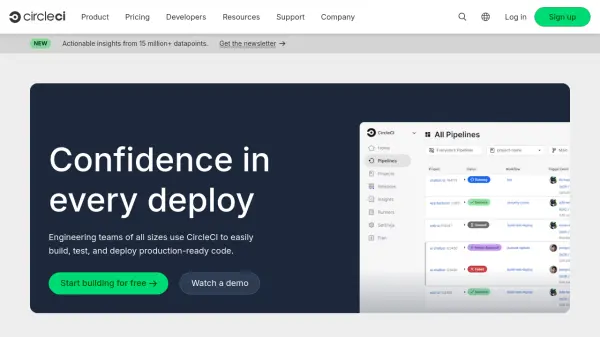What is Semaphore?
Semaphore enables software teams to efficiently build, test, and deploy their code by providing a robust platform for continuous integration and continuous delivery (CI/CD). The platform offers visual workflow design through Semaphore Canvas, supporting parallel processing, advanced automation, and real-time metrics for better performance and faster development cycles. With integration support for self-hosted, cloud, and hybrid deployments, Semaphore adapts to the unique needs of teams irrespective of size or infrastructure preferences.
Developers can leverage features like flaky test detection, targeted monorepo builds, and granular deployment controls to streamline processes and ensure secure, compliant release cycles. Its flexible pricing model and open source option make Semaphore accessible for hobbyists through to enterprise organizations, facilitating faster releases and reliable DevOps practices.
Features
- Visual Workflow Builder: Design and visualize pipelines with drag-and-drop interface using Semaphore Canvas
- Automated CI/CD Pipelines: Set up and manage continuous integration and deployment workflows
- Monorepo Support: Trigger targeted builds only for affected parts within monorepos
- Flaky Tests Dashboard: Identify and manage unreliable tests to improve build reliability
- Deployment Targets: Securely manage deployment processes and control release approvals
- Parameterized Deployments: Define custom forms and inputs for deployment workflows
- Real-Time Metrics and Reporting: Track pipeline performance and reliability over time
- Granular Access Control: Assign roles, permissions, and set up compliance with SCIM/SAML support
- Artifacts Management: Save and reuse artifacts across multiple pipelines
Use Cases
- Automating software build, test, and deployment processes
- Managing CI/CD for complex monorepos with targeted workflows
- Improving code quality by identifying and resolving flaky tests
- Visualizing and optimizing DevOps processes for faster feedback loops
- Enforcing secure and compliant releases in enterprise environments
- Supporting open source project builds with free parallel CI
- Transitioning from legacy CI tools like Jenkins to a cloud-based or hybrid pipeline platform
FAQs
-
What is the difference between Cloud and Hybrid plans?
Cloud plans have no per-seat cost but do not include access to self-hosted agents. Hybrid plans include access to self-hosted agents but add seat costs and provide identical in-app features otherwise. -
Can Semaphore be used for open-source projects?
Yes, Linux and macOS open-source projects can take advantage of Semaphore’s free parallel CI offering. -
How does Semaphore ensure security and compliance?
Semaphore features access control, SCIM/SAML support, deployment governance tools, audit logs, and robust infrastructure to ensure code security and compliance with industry standards. -
Are annual plans available?
Yes, annual subscription plans are available and typically include discounted pricing. Contact the customer success team for more details. -
What forms of payment does Semaphore accept?
Semaphore accepts all major credit cards and, for certain plans, offers additional payment options such as wire transfers; contact customer support for further details.
Related Queries
Helpful for people in the following professions
Featured Tools
Join Our Newsletter
Stay updated with the latest AI tools, news, and offers by subscribing to our weekly newsletter.








